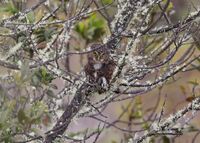Andean pygmy owl
| Andean Pygmy Owl | |
|---|---|

| |
| Scientific classification | |
| Kingdom Information | |
| Domain | Eukaryota |
| Kingdom | Animalia |
| Subkingdom | Bilateria |
| Branch | Deuterostomia |
| Phylum Information | |
| Phylum | Chordata |
| Sub-phylum | Vertebrata |
| Infraphylum | Gnathostomata |
| Class Information | |
| Superclass | Tetrapoda |
| Class | Aves |
| Sub-class | Neornithes |
| Infra-class | Neoaves |
| Order Information | |
| Order | Strigiformes |
| Family Information | |
| Family | Strigidae |
| Sub-family | Striginae |
| Genus Information | |
| Genus | Glaucidium |
| Species Information | |
| Species | G. jardinii |
| Population statistics | |
| Population | Unknown (2016 est.)[1] |
| Conservation status | Least concern[2] |
The Andean pygmy owl (Glaucidium jardinii) is a species of owl of the family Strigidae, and found alongside the Andean mountains of South America.
Description
The Andean Pygmy Owl is small, with a body length of 5.8 to 6.3 inches, and weigh 1.9 to 2.7 ounces. Males are slightly larger than females. The plumage is either dark brown or reddish to orange-brown, with a finely-spotted head. The wings are long in relation to body size and rounded at the end. The eyebrows are whitish and distinctive, yet its facial disk is poorly defined. The chest, sides and flanks are spotted or streaked in gray-brown to orange-brown.
The call is described as a sharp series of "hoop hoop hoop".[3] it was these calls, in addition to morphology, which led to recent case studies of Glaucidium pygmy owls, which determined that three of them (G. costaricanum, G. gnoma, G. jardinii) should be elevated to species level[4].
Range and habitat
The Andean Pygmy Owl is found on both sides of the Andes, from Venezuela south into Colombia, Ecuador, and northern Peru. It is found in semi-open, tropical and semi-tropical montane and cloud forests, from 6,000 to 10,500 feet elevation.
Habits
Like many other pygmy owls, the Andean pygmy owl is partially diurnal, actively hunting at dusk and dawn as well as at night; daylight activity can and does make it a frequent target of other birds, which try to drive it away. Prey animals consist of small birds, insects and small mammals, which are taken from perch-hunting. Apart from the use of abandoned woodpecker holes or the number of eggs laid, its reproductive biology is largely unknown.
